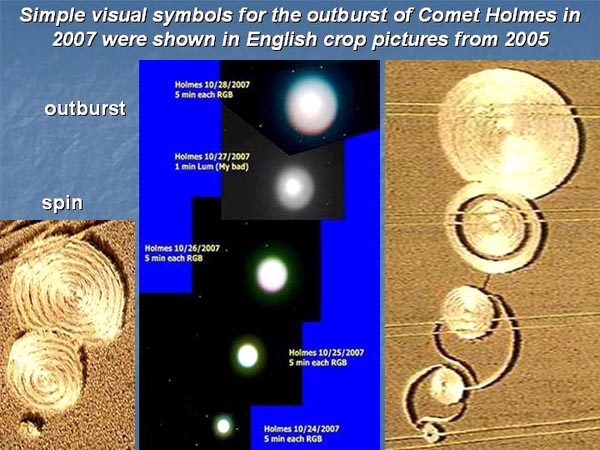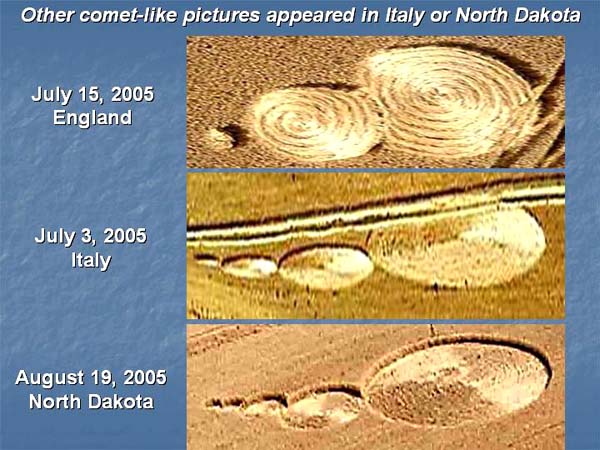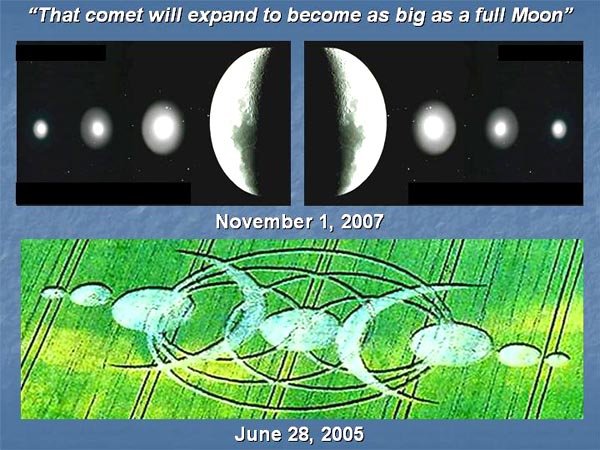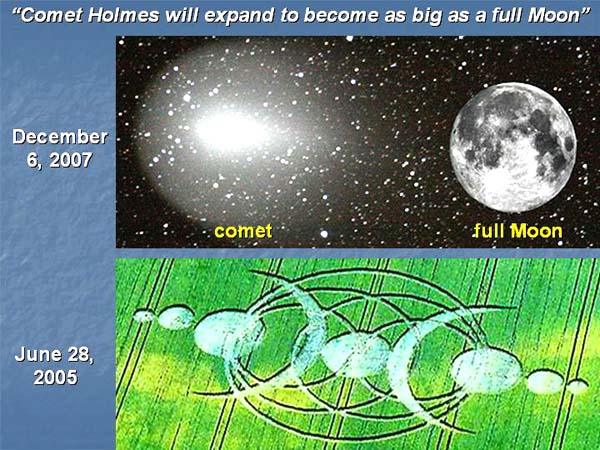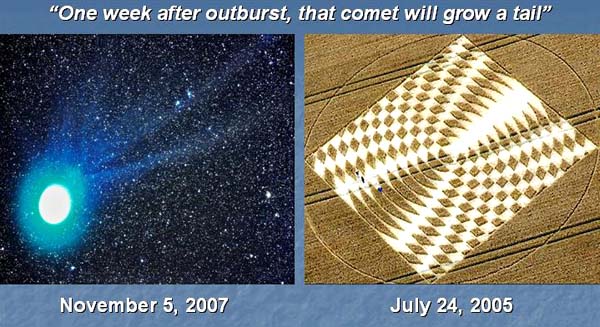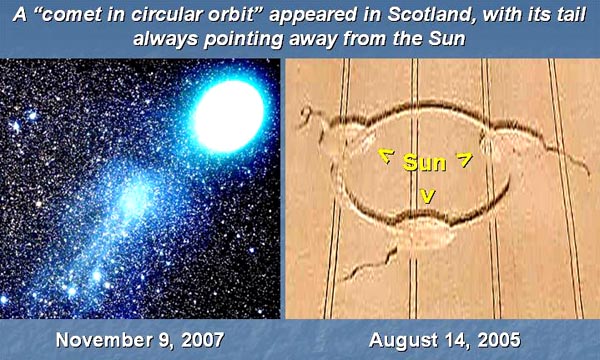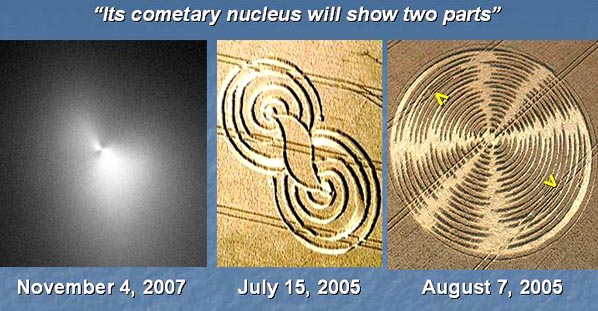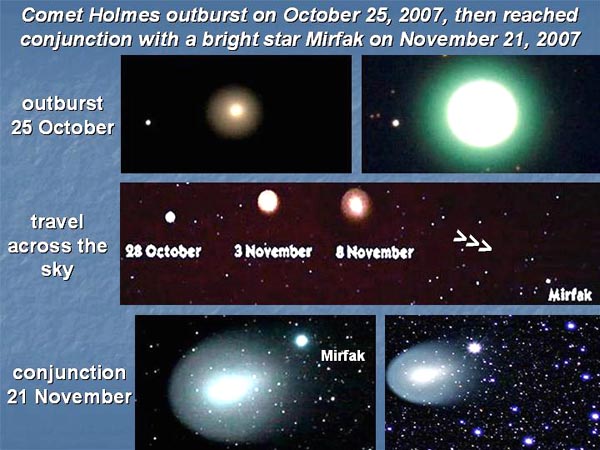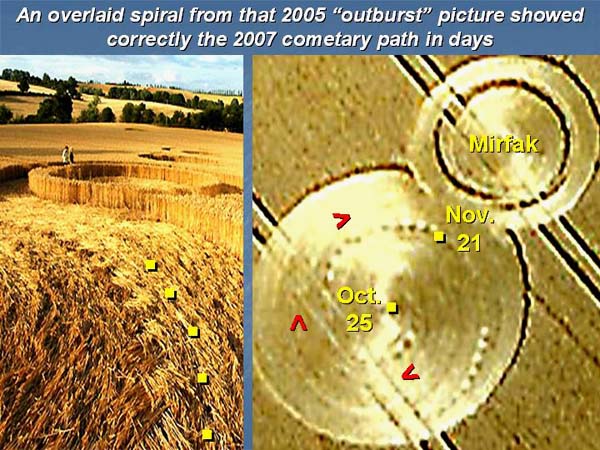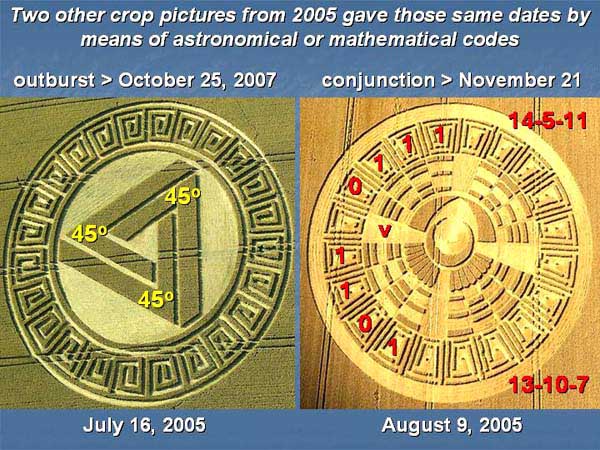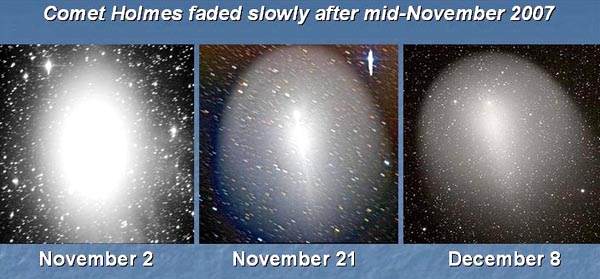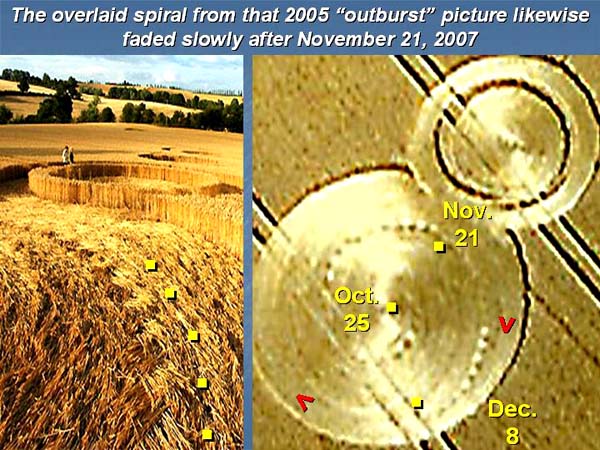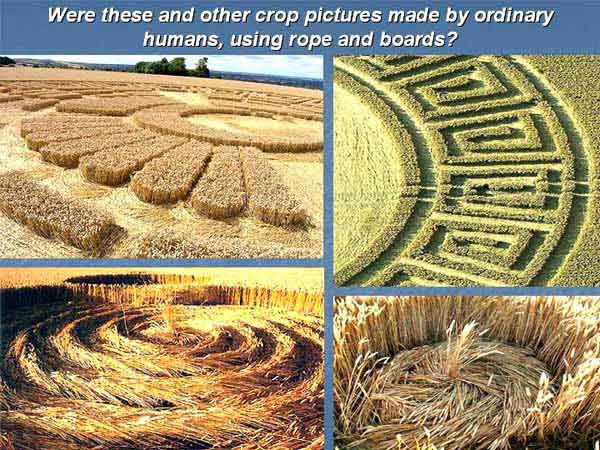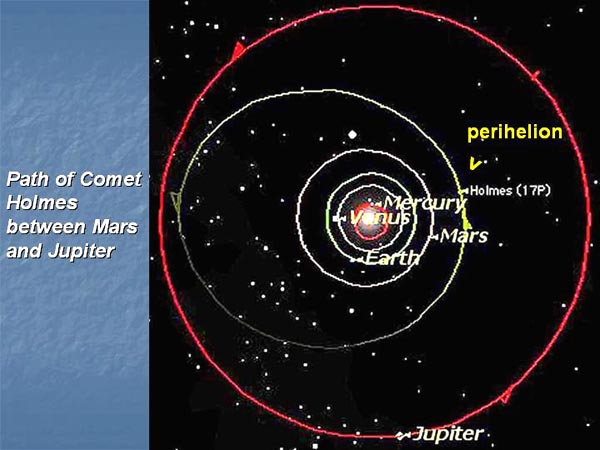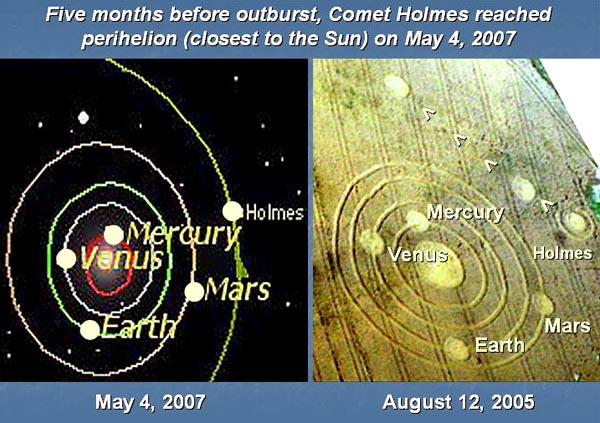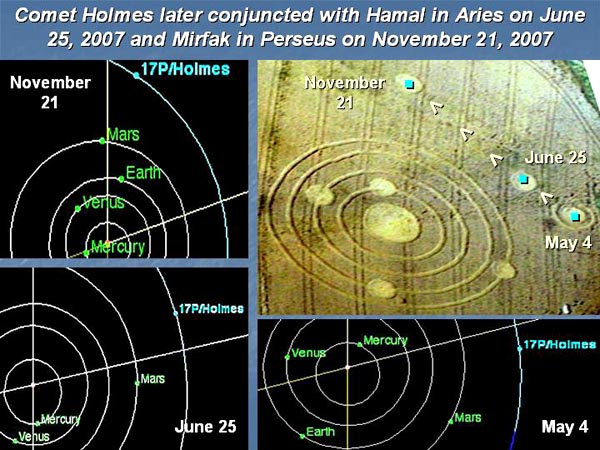|
Three significant events in the astronomy of Comet Holmes from 2007 were shown in English crop pictures from two years ago (in the summer of 2005)
In a previous article on this website, we noted how the
recent outburst of Comet Holmes on October 25, 2007 was
seemingly shown in certain crop pictures from the summer
of 2005, as was its conjunction with a bright star
Mirfak in Perseus on November 21, 2007.
Here we will extend and confirm that earlier analysis,
so as to place its logical and scientific conclusions
beyond any reasonable doubt. Thus, we will provide
many more simple visual comparisons between crop
pictures from 2005, and actual images of Comet Holmes
from 2007. Also, we will explain how the perihelion
(closest approach to the Sun) of Comet Holmes on May 4,
2007, as well as its gradual loss of intensity after
mid-November 2007, were also shown in English crop
pictures from two years ago.
Table 1. Three significant dates for Comet
Holmes in 2007 were predicted accurately by crop
pictures in 2005
Observations and speculations prior to 2007
Why wasn't all of this noted sooner? In fact, some of us
who do serious crop-circle research had become fully
aware, back in the summer of 2005, that something
important and astronomical had just been predicted for
two years later in 2007. For example, the journalist
Jaime Maussan said in an annual DVD summary of 2005 crop
pictures: "These are dates. Something is going to
happen then!"
(see www.cropcircleconnector.com/anasazi/circlechasers2005dvd.html to obtain a copy of that important prior documentation).
Also, we eventually figured out that the near-future
date of some unexpected astronomical event would be
November 21, 2007 plus or
minus two days
(see www.cropcircleconnector.com/2007/stanton/stanton2007.html). But we still didn't know exactly what would happen then, and we never expected a comet to explode! There was clearly going to be an astronomical event of some kind, because pictures of "explosions in space" had been shown in the fields, especially at Lane End Down on July 10, 2005. But a comet?
Only in retrospect, therefore, have we been able
to interpret many of those "future predictive" crop
pictures in their proper astrophysical context. It was
our fault, not theirs. Sufficient data were provided to
understand everything in advance, but we did not pay
enough attention. In particular, almost all of the
professional scientists on our little planet refused to
consider the subject in its entirety. That is at least
partly because, as Thomas Kuhn once noted (www.des.emory.edu/mfp/kuhnsyn.html):
"Scientists take great pains to defend the
assumption that they already know what the world is
like. To that end, normal science will often suppress
novelties which could undermine its current foundations.
Research is therefore not about discovering the unknown,
but rather a strenuous and devoted attempt to force
nature into the conceptual boxes supplied by
professional educators."
If you are a new reader, and do not yet know anything
factual or reliable concerning this phenomenon, you
might wish to start with a brief introductory set of
questions and answers on
www.cropcircleconnector.com/anasazi/faq98.html. For photographs of Comet Holmes, see www.spaceweather.com/comets/gallery_holmes.html or http://cometography.com/pcomets/017p.html.
Comet Holmes outburst or exploded
unexpectedly on October 24-25, 2007
Two months ago on October 24-25, 2007, an obscure comet
known as "17P Holmes" suddenly outburst or exploded
between the orbits of Mars and Jupiter. Astronomers
still have no good idea why that happened, because most
comets outburst when they approach the heat of the Sun.
In any case, many of us who are familiar with the
crop-messaging phenomenon saw immediately that
newly-taken photographs of that comet matched a famous
crop picture that had appeared at Garsington near Oxford
two years earlier on July 15, 2005:
Some astronomers believe that Comet Holmes was in rapid
spin prior to outburst. That may explain a series of
"internal spirals" shown in the small crop picture
above on left (four different crop pictures appeared at
Garsington on that day, all related to Comet Holmes in
one way or another).
Similar comet-like outbursts appeared in
crop pictures from Italy or North Dakota
The modern crop-picture phenomenon seems to be centred
on Avebury in southern England, but is certainly not
limited to that particular location. For example,
sometimes authentic crop pictures will appear in Germany
or Holland. In this case, two other 2005 "exploding
comet" pictures appeared in Italy or North Dakota
"Comet Holmes will expand to become as
large as a full Moon"
One of the most artistically-elegant crop pictures from
the summer of 2005 appeared at Cuxham on June 28, 2005.
No one at the time knew what it meant, yet in retrospect
we can see that it was meant to show how large Comet
Holmes would become after it exploded: as big as a full
Moon! It reached half the size of a full Moon by
November 1, 2007 just one week after outburst:
Later by December 6, 2007, it had become slightly bigger
than a full Moon as seen from Earth:
"Comet Holmes will slowly grow a tail"
Two weeks after outburst, Comet Holmes gradually grew a
two-pronged tail. That event seems to have been shown
schematically at Aldbourne on July 24, 2005.
A second crop picture which appeared at Aldbourne on the
same day showed the "magnetic field lines which surround
a charged triangle" (see
www.lucypringle.co.uk/photos/2005/uk2005bz.shtml).
Were the crop artists try to teach us something about
the physical mechanism of how comets grow tails? Might
the two-pronged tail of Comet Holmes be due to some
magnetic field structure that we cannot see?
Later in Scotland on August 14, 2005, we were shown the
slightly whimsical picture of a "comet in circular
orbit", with its curly tail always pointing away from a
central Sun:
The orbit of Comet Holmes is not as elliptical as
that of many other comets, and in fact is
almost circular as shown below.
"Its cometary nucleus will appear to be
divided into two parts"
As of the date when this is being written, Comet Holmes
has not yet split into two parts, but its
high-resolution Hubble image of November 4, 2007
certainly suggests the possibility:
A two-part nucleus for Comet Holmes was likewise shown
at Garsington on July 15, 2005, and at Shalbourne on
August 7, 2005.
"Its isophotes (lines of constant intensity)
will evolve slowly over time"
That crop picture from Shalbourne on August 7, 2005 also
showed, in addition to a two-part structure for Comet
Holmes, a series of concentric rings which were
apparently meant to represent lines of constant
intensity or "isophotes"
(see www.wvi.com/~rberry/astronomy/cometholmes/cometholmes.htm):
But then one would have to be a true cometary aficionado
to know that!
An overlaid spiral from that 2005 "outburst"
picture showed the 2007 cometary path in days
Now let us look at some detailed sky images of Comet
Holmes, in order to compare its time-dependent evolution
during late 2007 with dated predictions made in three
separate crop pictures from the summer of 2005. That
comet first exploded or outburst unexpectedly on October
24-25, 2007 as shown in the upper part of the figure
below:
Then it travelled across the sky through the
constellation Perseus (as seen from Earth), until it
reached or conjuncted with a bright star called Mirfak
on November 19-21, 2007, as shown in the lower part of
the figure above.
"An extraordinary sight will be visible in the sky
tonight, as a giant comet passes in front of a star.
Comet Holmes has put on a spectacular display over the
past three weeks. Tonight it is expected to shine even
brighter as it passes in front of Mirfak, the brightest
star in Perseus."
(see www.timesonline.co.uk/tol/news/uk/article2896442.ece). Now if we look again at that 2005 "outburst" picture which appeared at Garsington on July 15, 2005, we can see that it contained an "overlaid spiral" in addition to ordinary fallen crop within its largest circle. Individual data points from that spiral are marked with yellow squares on the left-hand side of the figure below:
Next, by studying that spiral from above (as shown
on the right-hand side), we can assign a calendar
date in "days" to each data point or yellow
square. One may begin rather simply in the centre
with "October 25" (when Comet Holmes exploded), then
continue down, around and up until a neighbouring
circle ("the star Mirfak") is reached on a day-count
of "November 21". At other dates past November 21,
that spiral begins to fade, as will be discussed
further below.
Another "overlaid spiral" appeared at Avebury
on July 27, 2005. There it was used to symbolize a
19-year cycle of our Moon (see
www.cropcircleconnector.com/anasazi/sundials2007b.html).
Other crop pictures from 2005 gave those
same dates of cometary outburst or conjunction using
codes
In order to teach us about Comet Holmes two years in
advance, those crop artists sent us, not only simple
visual images that anyone can understand, but also
certain astronomical or mathematical codes that only
a professional scientist can easily understand. They
did so, presumably, to establish their credibility
among certain members of the scientific profession
on modern Earth.
Two of those coded pictures are shown below. They
appeared at Waden Hill on July 16, 2005 or Wayland's
Smithy on August 9, 2005. Both were discussed in a
previous article on this website, so they will only
be mentioned briefly here:
A personal account of the discovery of Waden Hill by
Rod Bearcloud (see www.starnationgallery.com/articles/2007_3.html)
leaves essentially zero possibility that it could
have been made by local human fakers.
"How beautiful in the mind's eye is truth, and
how ugly is a lie."---John Locke, Essay on
Human Understanding, 1690.
Waden Hill showed an astronomical code
for outburst on October 24-25, 2007
Waden Hill of July 16, 2005 showed three "V"
shaped symbols inside of a big outer circle, which
was divided into 24 parts so as to symbolize "24
hours of astronomical Right Ascension". Each of
those "V" shaped symbols, known as semi-square in
astronomy or astrology, meant that one pair of
naked-eye astronomical objects would lie at 45
degrees to one another in Earth's sky (for
example Mars and Jupiter, or Venus and Saturn).
Three "V" shaped symbols therefore meant that three
pairs of naked-eye astronomical objects would lie at
45 degrees to one another in Earth's sky (see
http://en.wikipedia.org/wiki/Astrological_aspect).
Would such a rare triple alignment of planets or the
Sun happen on a calendar date two years later, when
that comet was pre-destined to outburst or explode?
This is a rather difficult problem to address, and
it can only be solved using an astronomical almanac
as say from Jodrell Bank (see
www.jb.man.ac.uk/almanac). The outburst date is
now known to be October 24-25, 2007; and yes, three
pairs of naked-eye objects did align themselves in
Earth's sky at 45 degree angles on that day! Another
crop picture from Garsington on July 15, 2005
further asserted that the cometary outburst date
of October 24, 2007 would be a Sun-Mercury
conjunction, as was again the case
Wayland's Smithy showed a
mathematical-calendar code for conjunction on
November 21, 2007
Wayland's Smithy of August 9, 2005 showed two
binary-hexadecimal dates in the context of an
ancient Sun-Venus, 52-year calendar
(see http://members.shaw.ca/mjfinley/4VENUS.htm or http://alignment2012.com/fap10.html). As shown in the picture above, "1-1-1-0" in base-2 translates to the number "14" in base-16 by means of the sum "8 + 4 + 2 + 0", while "1-1-0-1" in base-2 translates to "13" in base-16 by means of "8 + 4 + 0 +1". Each of those base-16 numbers "14-5-11" or "13-10-7" may then be switched into base-10 to yield decimal fractions of 0.85327 or 0.89722.
Each decimal fraction may then be read in the
context of a 52-year Mayan calendar that began on
April 10, 1961 and will end on March 28, 2013
(see www.cropcircleconnector.com/anasazi/time2007c.html). Both of those start-end dates are Sun-Venus conjunctions, and were specified symbolically by the crop artists in many pictures from 1997 to 2007. Wayland's Smithy also showed "20 Mayan days" around its big outer circle, in order to confirm which calendar its two dates might refer to.
In the context of such a calendar, one finds for
"13-10-7" or 0.85327 a modern Julian-Gregorian date
of "August 9, 2005", which was just the date when
that crop picture appeared. Problem solved! More
importantly, one finds for "14-5-11" or 0.89722
a modern date of "November 21, 2007", which was the
date when Comet Holmes conjuncted with Mirfak in
Perseus two years later (see
www.cropcircleconnector.com/2007/stanton/stanton2007.html).
And so that is how we knew that
something important and astronomical would happen in
November of 2007, although we never guessed that it
would be an exploding comet. It was always going to
be an astronomical explosion of some kind, because a
spherical body had been shown exploding in space
(along its six Euler axes x, y, z) with
stars all around it: see my previous essay on this
website
or www.lucypringle.co.uk/photos/2005/uk2005bh.shtml.
Who might be sending us these crop
pictures? Two culturally specific clues!
The use of an ancient Sun-Venus calendar at
Wayland's Smithy (and elsewhere) seems quite
culturally specific, since our knowledge of that
calendar comes mainly from the Venus Table of the
Dresden Codex (see
www.tulane.edu/~danny/dresden.html
or http://members.shaw.ca/mjfinley/4VENUS.htm). Could the British megalith builders, from whom these crop pictures apparently come, have taught that calendar to native people in central or southern America thousands of years ago? A second culturally-specific clue as to the mysterious origins of these pictures might be the "Jester's Hat" symbolism of Mayan kings (see www.cropcircleconnector.com/anasazi/time2007e.html or www.mesoweb.com/pari/publications/RT08/JesterGod.pdf).
Comet Holmes began to
fade in intensity after mid-November 2007
After it reached maximum brightness
around November 2, 2007 and conjuncted with Mirfak
on November 21, 2007, Comet Holmes slowly began to
fade as shown in the figure below:
"This comet is in super outburst, having
brightened by many magnitudes on the night of
October 24. It is in Perseus moving slowly. As
of December 1 it is fading, but still of
magnitude 3. Due to the energetic nature of the
outburst, the primary coma is expanding at a
rate of 1.4' per day. That has been its main
feature to see using a telescope or binoculars,
but is fading as the light spreads over a
greater area." (see
www.cometchasing.skyhound.com/index.html)
The overlaid spiral of crop from Garsington on
July 15, 2005 likewise began to fade after its
assigned date of "November 21, 2007", and had
faded almost completely by "December 8, 2007":
Did human fakers make these particular
crop pictures, which seemingly predict the future?
Sometimes even experts at crop-circle messaging may
be fooled by the best of human fakers, into
believing that "fake" crop pictures are
paranormal or "real". But does anyone really believe
that local human fakers could have made all of the
amazing crop pictures shown above, which seemingly
predict the future? When we look at those crop
pictures in closer detail, the construction task
facing any human faker with boards and rope seems
daunting:
Indeed, there
has never been any mention of the word "comet" on a
leading faker's website
www.circlemakers.org. That group accepts money to
create corporate logos in fields worldwide, and hence is
a commercial rather than a scientific venture. By
contrast, the true crop artists have shown a deep
interest in cometary astronomy since at least 1994
(see
www.cropcircleconnector.com/Millennium/scorpiushour.html).
Finally, could
any human faker have made another remarkable crop
picture from 2005, as will be discussed below? It was
artistically unattractive, but carried a deep
astronomical message that could not have easily been
deduced before Comet Holmes outburst a few weeks ago.
Comet Holmes
reached perihelion on May 4, 2007, five months before it
outburst or exploded
Most comets follow
elliptical orbits around our Sun, and so may come close to
the Sun at certain times, or proceed far from the Sun at
other times. The point in its orbit where any comet comes
closest to the Sun is known as "perihelion", whereas the
point in its orbit where any comet proceeds furthest from
the Sun is known as "aphelion". The slightly elliptical
orbit of comet 17P Holmes is shown by a thin white line in
the figure below:
It last reached perihelion (closest point to the Sun) on May
4, 2007, which was five months before it outburst or
exploded. At that time, it was almost invisible to most
telescopes on Earth because of its extreme dimness. No one
even cared about it,
except for a few comet enthusiasts. The four inner planets
of our solar system (Mercury, Venus, Earth and Mars)
each occupied a precise location in space relative to Comet
Holmes on that day (see above).
Now somewhat
remarkably, a almost exact copy of the schematic picture
just shown, for Comet Holmes at perihelion on May 4, 2007,
appeared in a field at Bluebell Hill in Kent two years
earlier on August 12, 2005:
At the time when that 2005
crop picture appeared, no one knew what it meant, nor did
not impress anyone with its artistic merit (see
www.medwaycropcircle.co.uk/2005.htm). Most enthusiasts
favoured an earlier crop picture from the same area that had
appeared on June 19, 2005. It was called the "Bluebell
Spinner", and was possibly symbolic of Comet Holmes in rapid
spin before outburst.
Could Bluebell Hill of
August 12, 2005 have been a human-made fake? Some people
thought so at the time; but can we always tell "fake from
real" simply by looking at some perceived neatness of the
crop? What if a relatively "messy" crop picture (made from
dry brittle plant stems) contains some deep intellectual
content, that no ordinary human faker could possibly
conceive of?
Conjunctions with Hamal on June 25, 2007 then
Mirfak on November 21, 2007
In order to address that question more thoroughly, let
us next examine several other aspects of the same crop
picture: namely its two outermost circles, and also the
precise location of Earth's Moon as shown there. At first, I
thought that those two outer
circles might represent "asteroids". But after studying
asteroid orbits on the websites NEO (http://neo.jpl.nasa.gov/orbits)
or JPL Small-Body Database Browser (http://ssd.jpl.nasa.gov/sbdb.cgi?sstr=17p&orb=1),
I found that most major asteroids such as Ceres lie further
beyond the orbit of Mars than the two outer circles as
shown.
Hence it became more likely that those two outer circles
were intended to represent "other orbital locations of Comet
Holmes", at dates later than May 4, 2007. With that idea in
mind, I used the NEO or JPL websites to generate orbital
diagrams for Comet Holmes at many later dates, and thereby
found good matches to a date of June 25, 2007 for the lower
circle, or November 21, 2007 for the upper (to an accuracy
of plus of minus five days):
Now when we examine the path through space of Comet Holmes
(see www.lunarplanner.com/Snippets/snippet.07.11.01-CometHolmes.html), we find that it came very close in Earth's sky to a bright star called Hamal in Aries on June 25, 2007. Later it came very close in Earth's sky to another bright star called Mirfak in Perseus on November 21, 2007. That latter date was also coded in hexadecimal as "14-5-11" at Wayland's Smithy, just a few days before on August 9, 2005.
Table 2. Three orbital locations of Comet Holmes
as shown two years earlier in an English crop picture
Relative
distances from the Sun of those three outer circles are also
approximately correct in astrophysical terms: Table 3. Relative distances from the Sun of Comet Holmes versus Mars orbit in Bluebell Hill of August 12, 2005
Those crop artists often portray successive locations of
some astronomical object along a single time-dependent
orbital track, as shown for Comet Holmes above. For example,
Jack Sullivan and Andy Thomas found that Mars was portrayed
in five successive orbital locations over the years
1995-2003, on the upcoming dates of Sun-Venus conjunctions
(see www.swirlednews.com/article.asp?artID=659 or www.cropcircleconnector.com/anasazi/time2007e.html).
Planetary, lunar or stellar conjunctions in Earth's sky
have always been a major subject of English crop pictures,
ever since the earliest days of Wiltshire 1990-1993, when
people imagined that "aliens were talking to them in the
fields". Instead, we were just being shown ancient
astronomical diagrams indicative of planetary conjunction or
opposition: say between Jupiter and Venus, or Venus and the
Moon
(see www.cropcircleconnector.com/anasazi/time2007f.html).
The phase of Earth's Moon as shown at Bluebell
Hill was also correct for a near-future date of May 4-5,
2007
Now let us ask whether the spatial location of Earth's Moon was portrayed correctly at Bluebell Hill in 2005, for a near-future date of May 4, 2007? In order to locate "Earth's Moon" in that crop picture, look for a small circle to the lower right of "planet Earth" in either figure above. The Moon was drawn there as being aligned at 45 degrees (three days) past full on May 2, 2007, and moving in the direction of Mars.
In fact, the true phase of Earth's Moon was three days past full on May 5, 2007, and it was moving in the direction of Mars as seen from Earth. Both the Moon and Mars shared similar values of Right Ascension on May 10, 2007 just six days later. Thus to an accuracy of one day, the Moon was indeed portrayed accurately at Bluebell Hill, for a near-future date when Comet Holmes would reach perihelion on May 4, 2007 (and five months before it exploded, when no one cared about it).
A friend who does UFO research told me recently, "Well, if you can figure it out, then someone else could have figured it out too. I am still not convinced that crop circles are made by anyone except humans with rope and boards!" A fair enough criticism, and it may have been true to some extent in the past.
But now in late 2007, following the outburst of Comet Holmes, we have finally been able to understand a series of intricately designed crop pictures from two years ago in the summer of 2005. Today in 2007, "someone else" could indeed go out and make approximate copies of those pictures in English fields, whether commissioned by the BBC, the Daily Mail, National Geographic, or various other media organizations which seem to spend a lot of time debunking this phenomenon, rather than telling the truth about it. But two years ago in 2005, nobody could have done so, because Comet Holmes was not important yet; and that is the bottom line.
Overwhelming physical evidence now exists for
crop circle reality as well as for astronomical future
prediction
To conclude, four stunning crop pictures from the summer of
2005---namely Garsington, Waden Hill, Wayland's Smithy and
Bluebell Hill---have now provided overwhelming physical
evidence to finally establish the paranormal reality of crop
pictures, as well as their ability to predict the future in
astronomical terms at least. As a long-term professional
scientist, I have found that the people most sceptical of
this strange phenomenon are the ones who know least about
it. Anyone can be a sceptic if they refuse to study the
evidence! That is not some philosophy to be admired, but
just plain ignorance.
A few misguided people have argued that "being a scientist
means being a sceptic" They often quote from Thomas Huxley
who wrote: “The improver of natural knowledge absolutely
refuses to acknowledge authority as such. For him,
scepticism is the highest of duties: blind faith
the one unpardonable sin.” Usually they quote his
second sentence, but not his first.
What Thomas Huxley wrote in 1866 (see
http://aleph0.clarku.edu/huxley/CE1/AdINKn.html)
is still true today! Every major authority on Earth keeps
telling us that modern crop pictures were made originally in
the early 1990's by two old English gentlemen after they
left the pub, or more recently by professional landscape
artists who take money from corporations to print their
logos in the fields. Unlike such "authorities", those of us
have studied the facts carefully for many years remain sceptical,
that any of those so-called authorities (who know little to
nothing about the subject) could be telling us the truth.
The one great unpardonable sin, in terms of scientific
integrity, would be to place blind faith in anything they
have to say.
Before sending this essay to Mark and Stuart, I showed its
figures to half a dozen other open-minded scientists here.
All were in agreement that such future-predictive crop
pictures are "real" and speak for themselves, although
there remained some dispute as to their possible origins.
Red Collie
"Time won't change you
Science won't change you Looks like I can't change you I try to talk to you, to make things clear but you're not even listening to me. I need something to change your mind."
Appendix.
Summary of messages from the crop artists in 2005
(in plain English)
Author's note:
these comments are necessarily subjective, yet several of my
friends thought that it would be important to append a brief
summary, since some people can understand pictures more
easily than words, and vice-versa.
One week ago on July 9
at Silbury, we showed you the picture
of a NASA space
probe as it impacted onto
the surface of Comet Tempel.
Then on the
next day at Lane End Down, we showed you the
picture of another comet which will explode
unexpectedly two years from now. We drew many "faint
stars" around that "exploding
comet"
in the field, so that you will
be able to confirm later
that we knew exactly
where in Earth's sky
the comet would
explode.
Today on July 15 at Garsington, we showed you four more crop pictures. The first was meant to tell how rapidly that comet will be spinning prior to outburst. The second was meant to tell how that comet will expand when it does outburst. The third was meant to tell how that comet will show a bipartite structure after it outbursts. The fourth was meant to tell when that astronomical event will happen. It will be on a day when Mercury enters into conjunction (i.e. direct alignment) with the Sun as seen from Earth. Yet Mercury orbits the Sun four times in any year, so tomorrow we will provide an even more direct date.
At Waden Hill, we
will show 24 hours of astronomical Right Ascension around
the outside of a big circle. Then on the inside of that circle,
will show three overlapping "V" symbols
as used in astronomy. Each
"V" means
that two planets happen to
be aligned in Earth's sky at 45 degrees
to one another. Since we
will show three "V"
symbols, that means
that six planets will be aligned in
pairs of 45 degrees on
a near-future date when
that comet will
explode. Later you will
find that the explosion date of October 24-25, 2007 was
foretold by our crop picture exactly. Near the
end of July at Collingbourne,
Ridgeway, Aldebourne and
Shalbourne, we will show four
more pictures of that
comet after it
explodes.
Then on August 9 at Wayland's Smithy, we will provide the precise date of a second important event, which will happen several weeks after that comet explodes: namely the day when it will conjunct (i.e. come very close in Earth's sky to) a bright star called Mirfak. This time we will show a big circle with "20 Mayan days" around its outside. That will tell you to read the dates given there using a traditional Mayan calendar, which is based on astronomical motions of Venus and the Sun. It is a calendar that we use here in ancient England. We taught it to the Olmecs in central America on one of our overseas missions there, and they will eventually pass it on to the Mayans.
Two dates will
be provided inside of that circle, using
a universal kind of mathematics in base-2 and base-16.
One date "13-10-7"
will match the day when that
crop picture appears
(August 9, 2005), to
provide an internal
check on your
calculations.
The other date
"14-5-11"
will match a
day over two years
later, when that
newly exploded comet
will conjunct a bright star Mirfak in Perseus
(November 21, 2007).
Finally at Bluebell Hill on
August 12, 2005, we will show you a picture or our inner
solar system for the near-future date of May 4, 2007, which
is when Comet Holmes will reach perihelion (i.e.
closest approach to the Sun). The location of Comet Holmes
on that day will be indicated clearly by a large outer
circle drawn just past the orbit of Mars, with another thin
circle drawn around it for emphasis. Two other orbital
locations of Comet Holmes for June 25, 2007 or November 21,
2007 will also be shown, because on those days it will pass
by two bright stars known as Hamal and Mirfak (as seen from
Earth).
Now Comet Holmes will not
explode until October 25, 2007! How could we possibly show
you a picture of Comet Holmes two years earlier on August
12, 2005, and also show its precise location in space on May
4, 2007 (five months before it exploded), unless we can see
into your future? Your greatest modern physicist Einstein
said: "The distinction between past, present, and future is
only a stubbornly persistent illusion." Do you believe him
now?
We have gone to all of
this trouble, so that you will know that we really can
see into
your modern future
on Earth, using our
advanced space time physics.
You do not yet possess such technology, but most
of your leading physicists including Thorne, Hawking,
Visser and Kaku believe
is possible.
All through the summer of 2006, we will show you many
different schematic pictures of wormholes, Roman rings
or closed time-like curves, to confirm that we know what we
are talking about. We call them "conduits"
through space or time.
Later in the summer of
2007, only a few months before that comet explodes, we will
show another series of pictures to help you understand
our Sun-Venus calendar. One of those pictures will be
recorded on camera as forming instantly at 3 AM one night,
with no one in the field below
(www.gazetteandherald.co.uk/news/headlines/display.var.1559662.0.the_crop_circle_mystery.php). What else do we have to do? The level of scientific proof that we have provided seems unequivocal. If we wrote simple messages to you in modern English (not our native language), people would pay even less attention.
Why are we doing all of
this? It is because the most likely
future of humans on 21st-century Earth appears very problematic,
or specifically "much
pain but still
time"
(see www.physi.uni-heidelberg.de/~petracek/glyphs/about_uk02dl.html or www.lucypringle.co.uk/articles/crabwood). Yet some of those unfavourable timelines can still be changed, if other unexpected astronomical events (yet to happen) are perceived correctly in advance. Our messages concerning Comet Holmes were intended to establish credibility, for other messages that you will receive soon. RED COLLIE |
